We may earn income from links in this post. Please read this Disclosure for details.
Discover what to eat in Aruba with our ultimate guide to the best traditional food in Aruba and the best restaurants to find it.
For such a tiny Caribbean island, Aruba has a highly sophisticated culinary scene. It’s an interesting kaleidoscope of international cuisine influenced by over 90 nationalities and cultures.
You can find it served in the over 200 fine dining restaurants, countless cafes and snack spots across the island.

During my two decades of visiting Aruba and writing for publications such as Aruba Nights and Fodor’s travel guides, I’ve learned that there are some distinctly local dishes that are woven deep into the mosaic of daily life that truly set it apart from other Caribbean islands.
Some dishes are steeped in tradition, others are seasonal, and some can be a tad difficult to find.
But it’s well worth the effort to seek them out to truly discover how locals like to eat, drink and be merry.
Here’s a list of traditional food you should try in Aruba and the best restaurants to find it at:
1. Stobas (stews)
A popular hot comfort food in Aruba is stew (stoba), enjoyed by Arubans despite the tropical climate. It’s typically made with beef or goat as its base, but calco stoba (conch stew) is also popular.
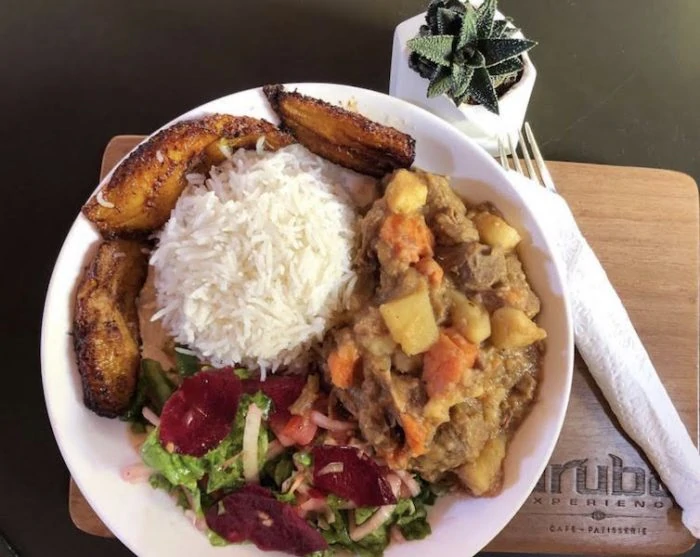
Though you typically had to go to a restaurant that specialized in cominda local (local cuisine) to find it, nowadays there are many new cafes and restaurants bringing it back to the forefront of mainstream cuisine and adding their own touches to make it look more appealing on a plate.
Eat Local Aruba is a treasure trove of resources for food fans interested in exploring local cuisine and supporting local producers. Check the Eat Local Aruba Facebook Page for updates.
One restaurant that’s a must-visit for stobas and other traditional food in Aruba is the Aruba Experience Café in Oranjestad.
2. Pastechi
Pastechis are deep-fried pastry pockets stuffed with myriad types of goodies. Typically you’ll find cheese, ham, beef, chicken or tuna inside a pastechi but you can sometimes find chop suey filling, thanks to the Asian influence on the island.
These half-moon shaped pastries are a popular grab-and-go breakfast staple for locals and you can see people lining up at their favourite take-out spots before the work day begins. They are an important part of the local culture.
Though pastechis are sold just about everywhere. They’re a handy and inexpensive snack so grab one to go when you’re out exploring Aruba’s attractions.
3. Keshi Yena
Often called Aruba’s national dish, this comfort food casserole was borne of necessity since it was created entirely of leftovers baked into a hollow rind of Edam Cheese!
Read about the history of Keshi Yena and get our Recipe to Make Keshi Yena at home.

Though not as popular or easy to find as the meat-based version, seafood stuffed keshi yena is also a traditional dish.
It’s on the menu at Gasparito Restaurant in Noord near the high rise hotels on Palm Beach as well as several of the restaurants listed in our post on the 10 Most Romantic Restaurants in Aruba.
4. Sopis (soups)
A top food in Aruba to try is soup. Arubans are big on hearty soups, especially fish soup (sopi di pisca) which will depend on the catch-of-the day for its base. And for the culinary adventurous there is also sopi di mondongo (tripe soup).
Yambo is the name for their Antillean style gumbo which features okra and gives it a slippery, stringy texture which garnered it the nickname “slimy soup.”
But don’t worry, it tastes better than it sounds!
If you happen to see sopi di pampuna featured on a restaurant menu anywhere – grab it!
This seriously delicious creamy pumpkin soup is enhanced with annatto seed and sometimes also contains bits of salted beef. Delicious!
5. Pisca Hasa and Other Fresh Fish in Aruba
Of course, being an island, Aruba is blessed with a bounty of goodies from the sea, and scads of seafood and fish restaurants preparing it a myriad of ways.
But when it comes to the traditional style of serving fresh fish, Arubans keep it very simple.
Pisca Hasa, simply translated, means fried fish. A typical Aruban catch-of-the-day meal would be a filet or whole fish fried or grilled.
It would then be topped with a rich red tomato-onion-peppers creole sauce and punctuated with spices like paprika and herbs like “yerbe di hole” the island’s pungent local basil.

The best spot to enjoy fish so fresh you can watch fishermen bring them straight from the pier to the grill to your table is at Zeerovers in Savaneta.
Read our post with everything you need to know about eating at Zeerovers.
Another top restaurant for fresh fish is Cuba’s Cookin’ where a must-try dish on the expansive lunch menu is Pescado a la Parrilla (grilled grouper), served with delectable sides of fresh mango salsa, black beans and caramelized plantain.
Insider tip: Driftwood Restaurant runs their own deep sea fishing charter, and if you book with them, they will cook your catch four ways and serve it communal style to you and your friends in their dining room.
6. Keri Keri
Though originally made with shark, any firm whitefish will do to make this dish. It’s made by mixing flaked stewed or leftover fish with sautéed annatto powder (achiote), fresh basil, onion, celery, tomato and green pepper.
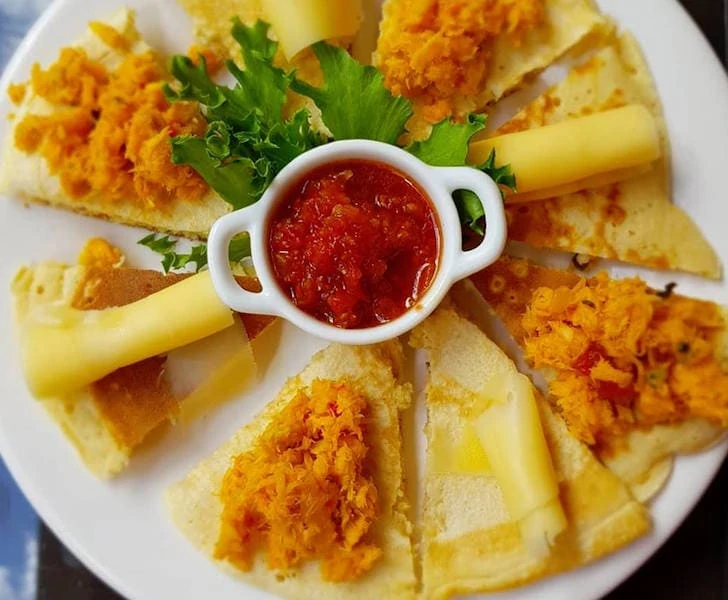
It’s most often served on its own or with a staple like rice.
7. Lobster, Shrimp and Prawns
As for seafood, Caribbean (rock) lobster and jumbo shrimp/prawn dishes are also treated without much fuss.
Try the jumbo fresh local steamed shrimps at legendary Charlie’s Bar in San Nicolas, open for lunch only.

Or look for local lobster grilled.
In Aruba, lobster is typically served grilled. The meat of this type of smaller, denser lobster stands up better to extreme heat than its counterpart you’d find in Atlantic Canada and New England where its usually served steamed.
8. Pan Bati
Pan bati is the proverbial Aruban side, meaning “smashed bread.”
It’s a thin corn flour pancake that’s ideal to soak up sauces or dip in soups. It’s also delicious on its own served hot with butter or deep fried and covered in melted Dutch cheese as a special treat.
You can also watch a cooking demonstration of pan bati at Coco Plum if you join Aruba Walking Tours for their Oranjestad adventure.
Read more about Aruba Walking Tours and other food experiences in our post on Eating Like a Local in Downtown Oranjestad.
9. Funchi and other Typical Sides
Other typical Aruban side staples include bananas hasa (fried plantains), arroz moro (beans and rice) and a cornmeal polenta called funchi.

Look for snack spots that serve funchi fries. These delicious local treats come topped with sea salt, black pepper and melted cheese and are downright addictive.
10. Ayacas
Up until recently, it was very tough to find ayacas in restaurants on Aruba unless you were on island at Christmas time.
They’re typically made in the home during the holidays and each family has their own secret recipe.
But now there are spots like Taste My Aruba often serving them up in single portions to give visitors the opportunity to taste this local holiday treat.

Originating in Latin America, ayacas are a delicious mixture of meats, usually chicken and ham mixed with spices, items like olives, raisins, pickled onions, prunes, cashews and the like.
The mixture is folded into an envelope of funchi and steamed in banana leaves. Delicious!
11. Siboyo Tempera
Made of slivered marinated onions and Madame Jeanette hot peppers (known as Madame Janette peppers in Aruba), you’ll often see siboyo tempera as a side condiment at almost every meal in Aruba.
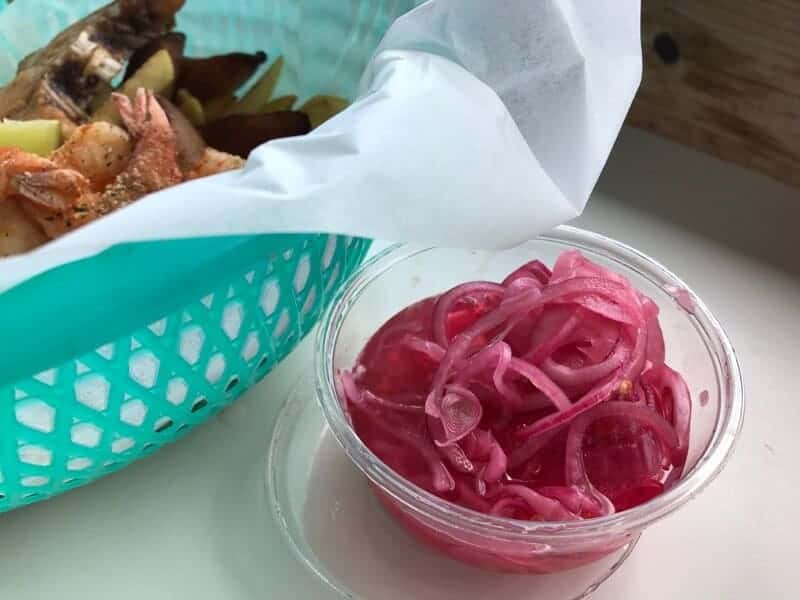
This tangy side with a bit of kick features the Madame Janette pepper from Suriname.
A fiery hot pepper that clocks in between 200,000 to 300,000 heat units on the Scoville Pepper Index, it’s on par with the habanero pepper for heat.
But rather than being simply scorching hot, the Madame Janette pepper has a sweetness that makes it especially delicious.
Get our easy recipe for siboyo tempera and make it at home to enjoy with grilled meats.
12. Pica
No self-respecting local diner would not have a bottle of “pica” within arm’s reach. It’s Aruba’s famous local hot sauce that they douse on everything except dessert!
It’s made from the island’s killer hot Madame Janette peppers, green papayas and spices. It makes a great souvenir, too.
13. Sacos & Food Trucks in Aruba
Great BBQ to-go has been a staple in San Nicolas at Saco di Felipe for decades. In fact, people drive all the way out there from the tourist strip to get their hands on big brown paper sacos (bags) of lip-smacking fare.
Ribs, chicken, pork chops, fries, salt fish and Johnny cake are all thrown in together with no utensils allowed!
But there are also all kinds of food trucks (truk’ di pan- bread trucks) scattered about serving the same kind of hearty fare to-go at excellent prices.
They open late for the after-the-party crowd and can stay open as late as 4 am.
14. Kesio
Dushi means sweet and Arubans like their sweets in cake, candy, and flan form the most.
Kesio or quesillo is the island’s answer to crème caramel or flan, and is a very popular dessert in Aruba . You’ll see it on a lot of menus.
15. Cocada and other Sweet Treats
And look to the corner stores, supermarkets and festival market stalls to find authentic “cos dushi”- house made goodies and sweets like cocada (a coconut candy) made with grated coconut, brown sugar and lime juice.
Enjoy this fudge-like candy for a quick energy boost any time of day.
Other tasty desserts on Aruba include soenchis (coloured meringue kisses) and lots of treats made with cashews.
16. Bolos (and other Aruban desserts)

When it’s party time, it’s all about the bolos! Aruban high layer cakes known as bolos are a must-have at every get-together.
If you’re lucky you’ll see some of the coolest ones like pistachio cake, cashew nut cake, or ponche crema cake, made with the island’s answer to liquor-laden eggnog, on the restaurant menu.
If you’d rather have an entire authentic Aruban cake, then you must go to Bright Bakery in Paradera.
It’s well worth the trip to visit the island’s most famous family-run bakery. It’s been in business since 1949.
17. Dutch Pancakes
Food influences from the Netherlands are also big on Aruba, and many Dutch expats craving a taste of home have recreated some delightful traditions on the island.
Pancakes are one of them.

Dutch pancakes are very different from their North American counterparts.
They’re thin and flat and more like crepes. They’re served stuffed or topped with a wide range of goodies, both sweet and savory!
Dutch pancakes are definitely a must-try food in Aruba. They are eaten for all meal times – breakfast, lunch and dinner.
Two ideal restaurants to sample tasty pancakes are Linda’s Dutch Pancakes (Google Map) and The Dutch Pancake House.
The latter boasting over 75 varieties, including poffertjes (silver-dollar sized) made with buckwheat flour and topped with powdered sugar.
18. Dutch Party and Bar Snacks
Decadent party snacks are also a Dutch-based indulgence you’ll find served at every party.
Many happy hours on Aruba feature snacks like frinkandel (spiced meat hog dogs), bitterballen (meat balls), kroket and deep-fried cheese balls.
Check out our post on restaurants and bars in Aruba for ideas on where to find these Dutch snacks.
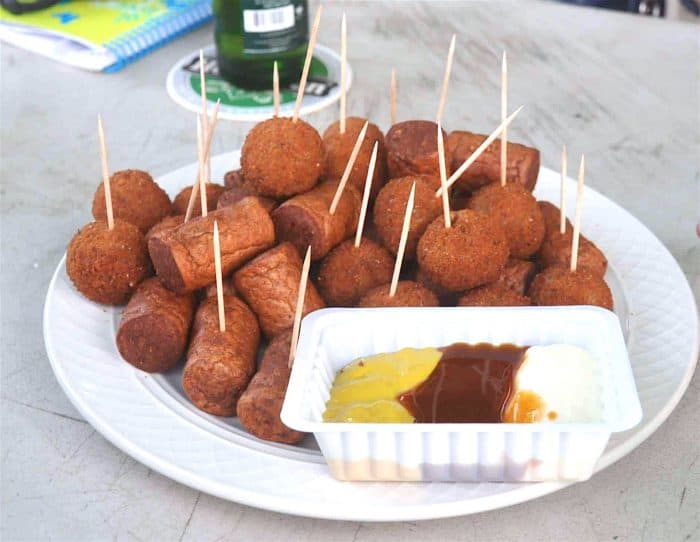
The Dutch love affair with Indonesian food finds satay with peanut sauce available throughout the island as well.
19. Dutch Cheeses
Of course, being in the Dutch Caribbean means top quality Dutch cheese is available everywhere. It’s enjoyed at breakfast, lunch and as a snack.
Gouda cheese is the best-known Dutch cheese followed by Edam, Maasdam, Leyden and other lesser known but equally delicious cheeses.

One of the must-try Dutch cheeses is Old Amsterdam Aged Gouda Cheese. The intense, buttery flavour of this yellow gouda is so full of character, it’s what locals eat in Aruba at parties, get-togethers and for snacks.
Buy some Old Amsterdam Aged Gouda Cheese at Super Food, the Dutch-owned supermarket in the Bubali neighbourhood near Eagle and Palm beaches. It’s a popular stop if you’re staying in one of the timeshares or resorts with kitchens.
Or, you can pick up some Old Amsterdam cheese at the gourmet food shops at Queen Beatrix International Airport.
More Aruba Food and Travel Inspiration
Local Food Theme Nights: “Local Food Nights” have become increasingly popular in hotel dining rooms. For example, every Monday night at Elements (one of our fave restaurants for vegan food) they serve an authentic Aruban menu.
The Mill Resort & Suites also frequently has “Aruban Night” on Fridays featuring island favourites like stobas.
Farmers Market: To sample all kinds of local products, visit the Santa Rosa Farmer’s Market. It takes place in the Piedra Plat area on the first Sunday of every month.
Supermarkets: Supermarkets are a treasure-trove of local foods, ready to eat and to take out. A top spot for groceries, deli salads, sliced meats, drop (Dutch licorice) and cheeses such as Old Amsterdam is Super Food in the Super Food Plaza.
If you’ve rented an apartment with a kitchen (like this luxury apartment in the Bubali neighbourhood) you’ll have fun exploring supermarkets such as Super Food and Ling & Sons.
Food Prices in Aruba: Like most other Caribbean islands, food prices are higher in Aruba than what you’ll find on the mainland. However, Dutch foods are surprisingly reasonably priced compared to what you’d spend in Canada or the U.S in a specialty food shop.

Food Truck Festival: Each April, food trucks gather for the annual Food Truck Festival so everyone can sample all the fun fare in one spot. It also features live music, craft beer and plenty of cuminda di truck.
Also check out these posts:
Save to Pinterest!
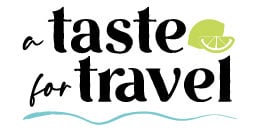




 Tortitas de Berro (Guatemalan Watercress Fritters)
Tortitas de Berro (Guatemalan Watercress Fritters)
Joanne balint
Can’t wait until next momday
Michele Peterson
Have a great trip! Aruba has some tasty food – you’re definitely going to eat well!
Joanne balint
Looks great
Laura
Sooo many tasty looking dishes on this list! My mouth is salivating now!
Xoxo,
Laura // afinnontheloose.com
Jacintha croes
Frikandel is not an aruban snack. Kroket is our version of a bitterball. Pancakes is based on preference and most places make American fluffy pancakes. Also the cheese thing is also not true. we do eat Dutch cheese but we dont eat cheese on a platter with other hams or meats. We will put a blok of cheese and ham with cibollin and olives on a stick as a party snack.
Doreen Pendgracs
Aruba looks like a great destination for foodies. I shall have to add it to my list.
Sue Reddel
Wow! Every one of these dishes looks better than the next. We definitely need to get to Aruba and taste every one of these.
Lori
I don’t even know where to start. So many wonderful local flavors some shared with other West Indian islands but with their own spin. You got me at the fruit covered pancakes. Off to Aruba!
Irene S. Levine
Your prose and photos have whet my appetite for a trip to Aruba! Great job!
Carol Colborn
Looks like they use a lot of annatto seeds for coloring and flavor. Would live to taste those atacas! The Dutch influence and seafiids galore!!!